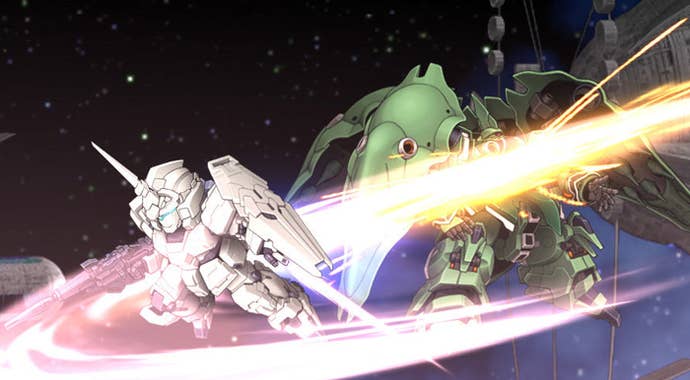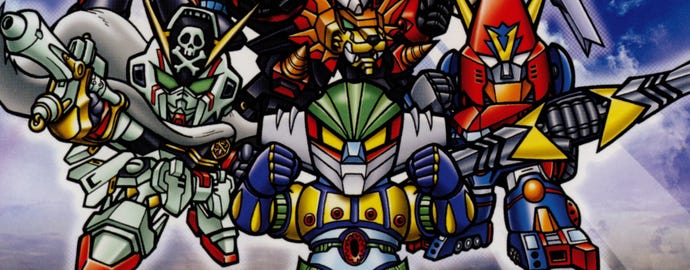Comfort Food Games: Super Robot Wars
Our resident mecha nut does her best to unpack the appeal of Japan's ultimate robot crossover series.
This article first appeared on USgamer, a partner publication of VG247. Some content, such as this article, has been migrated to VG247 for posterity after USgamer's closure - but it has not been edited or further vetted by the VG247 team.
Alright Star Wars fans, we're less than a year away from Star Wars Episode VII. EA is almost certainly showing something at E3. What if I were to tell you that they would be showing an RPG that gives you access to every major character from the Star Wars universe? And that it would cover the events of the new and old trilogies, complete with branching paths and unlockable units? Oh, and that it would make the prequels palatable?
Obviously, such a thing would never happen (haha... sigh), but that's the closest I can come to putting the appeal of Super Robot Wars into terms that western gamers can really understand. It's too simple to call it a love letter or an ode to mecha. In its own way, Super Robot Wars takes the spirit of a specific part of Japanese geek culture—mecha anime—and encodes it directly into a game. I'll be honest—there's not a lot like it on either side of the ocean. Of course, like many good things in the gaming industry, it tends to trapped in a cycle of questionable publishing practices; but ignoring the annual franchise component and the rampant sequelization, there's a purity to the love put into these games that pulls me back in time and again.
Its origins are on the original Game Boy, where a mostly unknown studio called Winkysoft published a tactical RPG featuring units from Mobile Suit Gundam, Mazinger, and Getter Robo—three shows that comprise the basic pillars of mecha. Even for the time, it was simple. Though the mechs themselves were rendered using large, attractive art assets, the animation was mostly static. There were no original generation units either—a staple in later games. Still, it managed to catch on with a significant enough audience to warrant a sequel on the Famicom, and the franchise that would ultimately comprise more than two dozen games was off and running.

I'll level with you: I haven't spent much time with the classic Super Robot Wars games. They have a certain old-school appeal, but they're also known for being both slow and brutally difficult. Scirroco—a recurring villain in Super Robot Wars 3—is both durable and exceptionally difficult to hit. There's a charming little bug in Chapter 7 that will lose you the bulk of your units forever if you're not wary enough. They're very much a throwback to the old days of gaming, when replayability was predicated as much on raw difficulty as on content.
My own introduction to Super Robot Wars came via Super Robot Wars W for the Nintendo DS, which is considerably easier than any of those games. So easy, in fact, that it is quite possible to solo the entire game with Boss Borot—a joke character from the Mazinger series. Even at the time, I was aware of how easy it was, but I was drawn in by its high production values and the presence of childhood favorite Voltron. And aside from that, I was looking for a reason to love Japan. I was brutally homesick back then, having been in Tokyo for about a year at that point. Super Robot Wars was attractive; felt reasonably deep, and gave me a good excuse to practice my reading and writing.
What's funny is that I knew next to nothing about mecha at the time. Most of the references flew over the my head, and I had no idea which character belonged to which show (well, except for Voltron), which I suppose is Super Robot Wars's secret to success. I was drawn in because I happened to recognize one robot; and by virtue of exposure to other units, I was eventually drawn to the likes of Mobile Suit Gundam, Macross, and Armored Trooper Votoms as well. I guess some might say that it's a glorified commercial for various mecha shows. I prefer to think of it as an ambassador for the genre; or if you prefer, the mecha equivalent of The Avengers—a massive crossover story that brings together a huge number of heroes for one rousing adventure.
At its worst, it can be fanboyish, shallow, and altogether too conservative. Detractors will rightly point out that though it's definitely gotten prettier over the years, the fundamental design has barely changed since the days of the original PlayStation, which is a fair point. At its best though, Super Robot Wars wields its source material like a scalpel, weaving it into every nook and cranny of the design. It can even elevate the original material at times. Super Robot Wars has long had a knack for softening annoying character traits; writing around nagging plot holes, and crafting logical relationships by pairing up the likes of Kira Yamato and Amuro Rey and watching them bounce off one another. The notoriously broken Gundam SEED Destiny is one series that has benefited greatly from the Super Robot Wars touch, mainly because other characters will happily call out Shinn and Kira on their BS at every opportunity.
It's that approach that goes a long way toward differentiating Super Robot Wars from other crossover games, most notably Bandai Namco's own Project x Zone. Super Robot Wars doesn't just toss a bunch of characters together and force them to wander from dimension to dimension; it weaves together a diverse array of storylines into a cohesive whole that can be a little overwhelming at times, but occasionally becomes a thing of beauty. I mean, my god, Super Robot Wars has Gundam's iconic dad figure Bright Noa slapping Shinji so hard that he finally emerges from his canonical stupor and becomes one of the universe's best pilots. Tell me that Evangelion fans haven't been rooting for that since the beginning of time (we'll just ignore the theatrical reboot).

It also happens to be a lot more fun to play than Project x Zone. I know it seems a little unfair to pick on one game, but its lack of depth really drove me crazy. It's a game that goes barely any deeper than hitting the same buttons over and over again to unleash the same tedious but attractive combos—something that Super Robot Wars occasionally gets accused of as well. The difference is ultimately in the customization. In most Super Robot Wars games, it's possible to swap pilots from unit to the next; put points into various attributes; attack custom parts, and build up pilot skills. There's an art to maximizing each unit's potential; and though it's occasionally possible to brute force the customization, it can make all the difference when hunting those difficult bonus objectives late in the game.
On the battlefield, the art of customization becomes the art of pacing and resource management. Much of the time, victory is predicated on knowing when to alpha strike an opponent into oblivion using a unit's best skills and attacks. It's those moments when Super Robot Wars reaches its crescendo. Cutscenes aren't any great thing anymore, but Super Robot Wars is one of the few games that can still recall the excitement and impact of the old summon sequences of Final Fantasy VII and its ilk. They're used to punctuate the often huge amount of damage that comes with a well-constructed series of skill buffs—a just reward for a job well done. It's tempting to call it all fluff; and in some ways, I would agree with that sentiment. But I also admire the detail and craftmanship that encapsulates everything from the goofy 70s (that scratchy graphics filter!) to the modern day. And more importantly, I appreciate that the attacks are mostly in the service of actual depth, rather than serving as a substitute for it.
Honestly, it's tough to unpack all these reasons that I still enjoy Super Robot Wars. Even after all these years, I struggle to explain the appeal to outsiders, except to make imperfect comparisons to The Avengers and Star Wars despite here being no western analogue for the impact that Super Robot Wars has had on the genre at large. Over the years, Super Robot Wars has shined a light on plenty of shows that have been otherwise forgotten in Japan—from Kotetsu Jeeg to G Gundam—and contributed to their revival. Units created specially for the series, like the popular Mazinkaiser, have gone on to star in their own shows. And well-known mecha designers, like Hajime Katoki, have contributed original designs to the series. In many ways, mecha owes as much to SRW as SRW owes to mecha. The two are almost inseparable.
Over the years, I've gained a greater appreciation for its contributions as a sort of museum for 50 years of mecha history—a genre that remains under-appreciated even in anime circles. But it also has a personal appeal to me as tangible connection to the life I had in Japan, which I miss dearly. For me, it's become the definition of comfort food gaming. It's not the easiest thing in the world to explain to my friends, but I'm sort of okay with that now. It can be my little secret.



